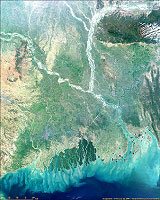 |
| View of Bangladesh from space, showing the Padma (Ganges) and Jamuna Rivers flowing together before they empty into the Bay of Bengal. http://visibleearth.nasa.gov/cgi-bin/viewrecord?773) (Click for larger image) |
 |
| View of Bangladesh from space, showing the Padma (Ganges) and Jamuna Rivers flowing together before they empty into the Bay of Bengal. http://visibleearth.nasa.gov/cgi-bin/viewrecord?773) (Click for larger image) |
|
An arm of the Indian Ocean, the Bay of Bengal is 1,300 miles (2,090 km) long and 1,000 miles (1,610 km) wide, bordered on the west by Sri Lanka and India, on the north by Bangladesh, and on the east by Myanmar and Thailand. The Andaman and Nicobar Islands separate it from the Andaman Sea, its eastern arm. Major rivers drain 200 km3 of water and introduce tons of silt during the monsoon season (July through September in India, with similar patterns in Bangladesh and Burma), strongly influencing the dynamics of the ecosystem resulting in silting in harbors and creation of sand bars near river mouths. The large rivers form fertile, heavily populated deltas. Sediment from the rivers has made the bay a shallow sea, and the fresh water run off have reduced the salinity of surface waters along the shore. Monsoon rains and destructive cyclone storms have caused great loss of life along the bay's northern coast. Monsoon waters have a strong influence on the dynamics of the Bay, producing a warm, low-salinity, nutrient-rich, oxygen rich layer to 100 m depth, approximately 1500 km from the northern portion of the Bay where the rivers enter the sea. In deeper waters (200 m and 500 m), high salinity, low temperature, low-oxygen waters persist through the year. The coastal ecosystems include productive wetlands, mangroves, and backwaters. The Bay of Bengal's Sunderbans is the largest estuarine delta in the world and is home to the biggest colony of the Royal Bengal Tigers. The evergreen mangrove forests of Suderbans host a diversity of life. The land is split by many rivers and channels all emptying into the Bay. Project Tiger was implemented here in 1973 and later the Sunderbans Tiger Reserve was formed covering an area of over 2,585-sq km. The core area of 1,330 sq km has been declared a national park and a world heritage site. The reserve has a tiger population of 287(1984 census). |